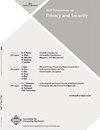Euler: Detecting Network Lateral Movement via Scalable Temporal Link Prediction
IF 2.8
4区 计算机科学
Q2 COMPUTER SCIENCE, INFORMATION SYSTEMS
引用次数: 17
Abstract
Lateral movement is a key stage of system compromise used by advanced persistent threats. Detecting it is no simple task. When network host logs are abstracted into discrete temporal graphs, the problem can be reframed as anomalous edge detection in an evolving network. Research in modern deep graph learning techniques has produced many creative and complicated models for this task. However, as is the case in many machine learning fields, the generality of models is of paramount importance for accuracy and scalability during training and inference. In this article, we propose a formalized approach to this problem with a framework we call Euler. It consists of a model-agnostic graph neural network stacked upon a model-agnostic sequence encoding layer such as a recurrent neural network. Models built according to the Euler framework can easily distribute their graph convolutional layers across multiple machines for large performance improvements. Additionally, we demonstrate that Euler-based models are as good, or better, than every state-of-the-art approach to anomalous link detection and prediction that we tested. As anomaly-based intrusion detection systems, our models efficiently identified anomalous connections between entities with high precision and outperformed all other unsupervised techniques for anomalous lateral movement detection. Additionally, we show that as a piece of a larger anomaly detection pipeline, Euler models perform well enough for use in real-world systems. With more advanced, yet still lightweight, alerting mechanisms ingesting the embeddings produced by Euler models, precision is boosted from 0.243, to 0.986 on real-world network traffic.Euler:通过可伸缩的时间链路预测检测网络横向移动
横向移动是高级持续威胁所使用的系统折衷的关键阶段。检测它不是一项简单的任务。当网络主机日志被抽象为离散的时间图时,该问题可以被重新定义为进化网络中的异常边缘检测。现代深度图学习技术的研究已经为这项任务产生了许多创造性的复杂模型。然而,与许多机器学习领域的情况一样,模型的通用性对于训练和推理过程中的准确性和可扩展性至关重要。在本文中,我们提出了一种形式化的方法来解决这个问题,我们称之为Euler的框架。它由堆叠在模型不可知序列编码层(如递归神经网络)上的模型不可知图神经网络组成。根据Euler框架构建的模型可以很容易地将其图卷积层分布在多台机器上,以大幅提高性能。此外,我们证明了基于欧拉的模型与我们测试的所有最先进的异常链路检测和预测方法一样好,甚至更好。作为基于异常的入侵检测系统,我们的模型以高精度有效地识别了实体之间的异常连接,并在异常横向移动检测方面优于所有其他无监督技术。此外,我们还表明,作为一个更大的异常检测管道的一部分,欧拉模型的性能足以在现实世界的系统中使用。随着更先进但仍然轻量级的警报机制吸收了欧拉模型产生的嵌入,真实世界网络流量的精度从0.243提高到0.986。
本文章由计算机程序翻译,如有差异,请以英文原文为准。
求助全文
约1分钟内获得全文
求助全文
来源期刊

ACM Transactions on Privacy and Security
Computer Science-General Computer Science
CiteScore
5.20
自引率
0.00%
发文量
52
期刊介绍:
ACM Transactions on Privacy and Security (TOPS) (formerly known as TISSEC) publishes high-quality research results in the fields of information and system security and privacy. Studies addressing all aspects of these fields are welcomed, ranging from technologies, to systems and applications, to the crafting of policies.
 求助内容:
求助内容: 应助结果提醒方式:
应助结果提醒方式:


